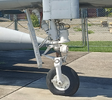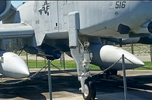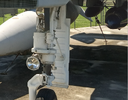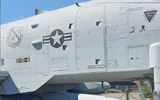DavidsScaleModels
Well-Known Member
- Joined
- Sep 16, 2022
- Messages
- 144
This next commission build is another A-10. I will be using Academy's 1/48 A-10C "75th FS Flying Tigers" kit. The scheme will be how this aircraft looked in 2014. I will be adding Eduard photo etch detail set, Master Model brass gun, Ares resin ejection seat, and I will be using eight LED's and some fiber optics to illuminate the aircraft. It will be mounted on a wood base with a hidden battery and switch to turn the lights off and on. The LED's are from Evan's Design and are their PICO size LED's one of which is a flashing red. This will be for the upper and lower lights of the fuselage. The LED will hook to two fiber optic lines so the flashing lights will flash together.
I started off building the nose gear bay. The kit bay is very detailed and very close to the reference photos. The strut itself was modified using the Eduard photo etch set. The nose gear strut has two landing lights mounted on it and the kit has them as separate parts. I drilled out the lens portion. I then cut a small slit along the bottom for the wiring. The PICO size LED's fit perfectly inside the light housing. These were glued in using acrylic gel and then the clear lens from the kit was attached to the front. The lights were then mounted to the strut and the wiring was then routed up and through the rear bulk head when I installed the strut into the bay. I also added some detail wiring on the strut and the nose wheel.
Next I turned to the cockpit. The Eduard set includes all the panels for the cockpit tub and the instrument panel. I cleaned up the tub and instrument panel then painted and applied the photo etch.
I am working on the Ares resin ejection seat now and then I can assemble the forward section of the fuselage.
You can see all the photos and details from the start in the build log at: https://davidsscalemodels.com/build-log/1-48-a-10c-75th-flying-tigers/










I started off building the nose gear bay. The kit bay is very detailed and very close to the reference photos. The strut itself was modified using the Eduard photo etch set. The nose gear strut has two landing lights mounted on it and the kit has them as separate parts. I drilled out the lens portion. I then cut a small slit along the bottom for the wiring. The PICO size LED's fit perfectly inside the light housing. These were glued in using acrylic gel and then the clear lens from the kit was attached to the front. The lights were then mounted to the strut and the wiring was then routed up and through the rear bulk head when I installed the strut into the bay. I also added some detail wiring on the strut and the nose wheel.
Next I turned to the cockpit. The Eduard set includes all the panels for the cockpit tub and the instrument panel. I cleaned up the tub and instrument panel then painted and applied the photo etch.
I am working on the Ares resin ejection seat now and then I can assemble the forward section of the fuselage.
You can see all the photos and details from the start in the build log at: https://davidsscalemodels.com/build-log/1-48-a-10c-75th-flying-tigers/


























































